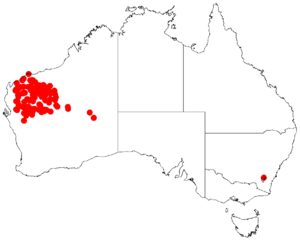Black mulga facts for kids
Quick facts for kids Black Mulga |
|
|---|---|
| Scientific classification | |
| Genus: |
Acacia
|
| Species: |
citrinoviridis
|
 |
|
| Occurrence data from AVH | |
The Acacia citrinoviridis, often called black mulga, river jam, milhan or wantan, is a type of tree. It belongs to the plant family called Fabaceae, which includes peas and beans. This tree naturally grows in western Australia.
About the Black Mulga Tree
The black mulga tree usually grows to be about 5 to 15 meters (16 to 49 feet) tall. It often has branches that droop downwards, giving it a "weeping" look. This tree typically has one main trunk. Its trunk and bigger branches are covered in grey bark that has many cracks, which is called "fissured bark."
Like most Acacia trees, the black mulga doesn't have regular leaves. Instead, it has special leaf-like parts called phyllodes. These phyllodes are a grey-olive color. They can grow up to 12 centimeters (about 5 inches) long and about 1 centimeter (less than half an inch) wide.
The flowers of the black mulga are yellow. They grow in long, tube-shaped groups. After flowering, the tree produces seed pods. These pods are about 8 centimeters (3 inches) long and have a soft, fuzzy, lemon-green covering. From far away, the black mulga looks a lot like another tree called mulga. However, you can tell them apart because the black mulga has darker bark.
Where Black Mulga Grows
This tree is special because it is endemic to certain areas. This means it only grows naturally in the Pilbara and northern parts of the Mid West regions of Western Australia. You can find black mulga trees growing along creeks and rivers. They live in areas that are "semi-arid," meaning they are quite dry.
These trees are often found in rocky riverbeds and creek beds. They also grow on stony plains and rocky hills. The black mulga prefers to grow in soils that are stony loam, clay loam, or red sandy soils. These areas are mostly north of towns like Carnarvon and Meekatharra.

